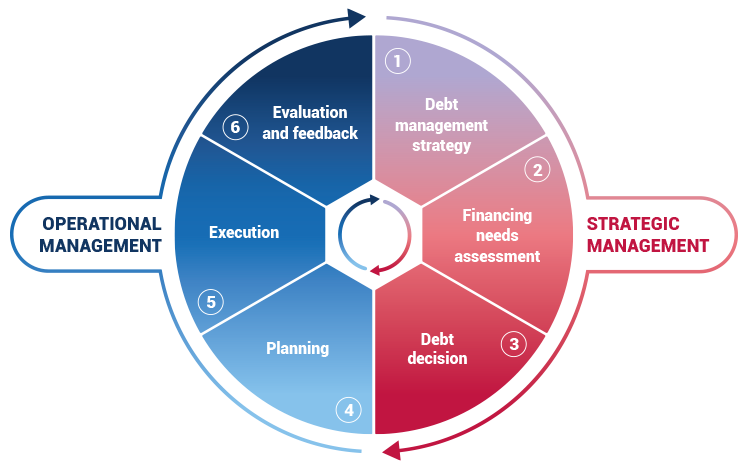Reliable Debt Consolidation Techniques for Financial Liberty: More Discussion Posted Here
Wiki Article
Whatever You Need to Find Out About Developing an Individualized Debt Administration Plan
In the world of personal finance, designing a tailored financial debt management strategy is commonly the foundation of achieving monetary stability and peace of mind. As you browse the intricacies of creating an individualized debt administration strategy, recognizing the ins and outs of each action is key to your financial success.Assessing Your Existing Financial Obligation Scenario
One need to first perform a complete evaluation of their present financial obligation commitments before formulating an efficient financial debt monitoring plan. Produce an in-depth listing of each debt, including the complete quantity owed, interest rates, minimum month-to-month payments, and due days.After compiling this information, determine your complete debt-to-income ratio by separating your regular monthly debt repayments by your monthly revenue. Comprehending these elements of your financial scenario will assist you in developing a personalized financial obligation monitoring plan tailored to your specific requirements and objectives.
Setting Financial Goals and Targets

When establishing financial objectives, it is essential to be certain, measurable, possible, pertinent, and time-bound (WISE) For example, you may establish an objective to settle a specific amount of financial obligation within a particular time frame, such as lowering your bank card equilibrium by $5,000 in the next one year - More Discussion Posted Here. By setting clear targets like this, you can track your progress and stay encouraged to attain your financial obligation management purposes
Furthermore, consider prioritizing your financial obligations based upon factors such as rates of interest, outstanding balances, and repayment terms. By concentrating on high-interest debts first, you can conserve cash in the long run and increase your trip toward monetary liberty. Remember, everyone's economic situation is distinct, so customize your targets and goals to fit your private demands and conditions.
Creating a Realistic Spending Plan
Crafting a well-defined spending plan is an essential action in efficient financial debt management and financial planning. A sensible spending plan functions as a roadmap for your financial health, assisting you track your earnings, costs, and financial debt payments. To create a functional spending plan, start by providing all your resources of earnings. This includes your wage, side hustle incomes, or any type of other monetary inflows. Next, brochure all your dealt with expenditures such as rent or mortgage, utilities, insurance, and funding settlements. Variable expenditures like groceries, amusement, and transport ought to likewise be consisted of. Separate between wants and needs to prioritize necessary costs and identify areas where you can cut down.When setting spending plan restrictions, be honest with on your own concerning your spending practices and financial responsibilities. Designate a section of your revenue in the direction of settling financial debt while guaranteeing you have some funds for cost savings and emergency blog here situations. Routinely testimonial and adjust your budget as needed to remain on track with your economic objectives and debt payment plan. By sticking to a realistic spending plan, you can properly manage your financial obligation and work in the direction of a more protected monetary future.
Discovering Debt Settlement Techniques
After establishing a sensible budget plan, the next essential action in effective debt administration is to check out numerous financial debt repayment methods. One typical technique is the snowball method, where you concentrate on paying off the smallest financial obligations initially while making minimal repayments on larger debts. This technique can assist build energy as you see smaller financial obligations being gotten rid of, supplying motivation to tackle bigger ones.One more approach is the avalanche technique, which includes focusing on debts with the highest possible rates of interest. By targeting high-interest debts initially, you can decrease the overall quantity you pay in passion gradually. This technique may be a lot more cost-effective in the long run, even though it could take longer to see individual financial obligations fully settled.
Financial obligation combination is another alternative where you combine numerous financial obligations right into a solitary loan with a lower rate of interest. This can streamline your settlement procedure and potentially reduce the complete passion paid. However, it's necessary to carefully think about the terms and fees connected with combination to ensure it's the ideal selection for your monetary circumstance.
Tracking and Changing Your Plan

Adjusting your plan may entail reapportioning funds to take on high-interest financial debts first, negotiating with financial institutions for lower interest rates or much better payment terms, or discovering extra revenue resources to expedite financial obligation payment. As your economic circumstance advances, your financial debt management plan ought to adapt accordingly why not try this out to remain effective. By staying flexible and positive in tracking and changing your strategy, you can maximize your efforts towards settling your financial debts efficiently and accomplishing your monetary objectives.
Verdict
To conclude, creating a tailored debt administration plan entails evaluating present financial debt, establishing monetary objectives, creating a sensible budget, exploring repayment approaches, and surveillance and readjusting the strategy as required. By complying with these actions, individuals can take control of their economic situation and job in the direction of ending up being debt-free. It is necessary to remain self-displined and devoted to the strategy in order to achieve lasting economic stability.
One have to initially perform an extensive evaluation of their present financial debt commitments prior to formulating an effective financial obligation monitoring strategy.After developing a reasonable budget, the following essential step in reliable debt management is to explore numerous financial obligation repayment strategies - More Discussion Posted Here.To efficiently handle your debt, constant tracking and change of your debt monitoring plan are crucial elements for long-lasting economic security.Changing your strategy might include reallocating funds to deal with high-interest financial debts first, discussing with lenders for lower rate of interest prices or better go to website repayment terms, or checking out additional earnings resources to quicken financial debt repayment.In conclusion, developing a tailored financial obligation management plan entails examining existing financial debt, setting economic goals, creating a realistic budget plan, exploring repayment techniques, and tracking and adjusting the strategy as required
Report this wiki page